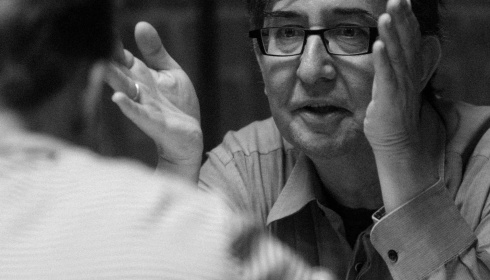
Cassiers got his inspiration for the second part Wolfskers in three film scenarios from the Russian movie director Aleksandr Sokurov about Lenin, Hitler and Hirohito.
In his movies Sokurov shows the three rulers in their passivity and their lethargy rather than in their moments of power and decision-making. Sokurov is less interested in the detailed historical context of his leading characters. Hence he focuses on ‘lost’ moments in their life. Creating a certain atmosphere is an important item within his movie aesthetics. Sokurov says he is interested in man and what happens to him when he gains power: “These people in powerful positions have turned their life into theatre. Led by a certain myth they have shaped their life, staged it, adjusted it and made it subject to rituals and ceremonies.” Whilst for Kurt Köpler in Mefisto for ever the theatre is his reality, the three rulers in the Sokurovs movies have turned the reality into their theatre. Sokurov shows the ruler as a perverted artist, but at the time when the façade is crumbling away.
In Wolfskers Guy Cassiers (in cooperation with the author Jeroen Olyslaegers) cuts these three movie scenarios up amongst each other and follows the three leading characters during a day in their life. In the production of Cassiers the three leading characters are static. It is their ‘household’ that is continuously on the move. The roles of the three households are played by one and the same group of actors: they constitute the dynamic element of the performance. Wolfskers shows how power attacks the rulers as well as their surroundings like an insidious poison.
TRIPTYCH OF POWER
After his impressive Proust cycle, a poignant and subdued theatrical meditation about memory and lost time, Guy Cassiers focuses on the complex connection between art, politics and power in a new trilogy, the Triptych of Power. The first part Mefisto for ever, based on the novel Mephisto by Klaus Mann, was first performed in the autumn of 2006. Cassiers got his inspiration for the second part Wolfskers in three film scenarios from the Russian movie director Aleksandr Sokurov about Lenin, Hitler and Hirohito. The third part Atropa. Avenging peace reaches back to the Greek tragedies and more specifically those featuring the Trojan War. Although the three parts can be viewed as separate performances, also in this case the whole is more than just the sum of its parts. Just like in the case of the Proust cycle the trilogy offers the possibility of deepening and broadening the theme. As the trilogy builds up, more and more echoes are sounding along. Mefisto for ever narrates the story of (diabolical) seduction by power. Wolfskers is the story of poisoning by power (Wolfskers is the name of a poisonous plant). And finally Atropa. Avenging peace tells the story of the agony of power (as well as a family of poisonous plants, Atropa is the name of one of the Greek Fates who cuts the thread of life).
director
- Guy Cassiers
adaptation
- Guy Cassiers
- Erwin Jans
- Jeroen Olyslaegers
after
- Yury Arabov / Aleksandr Sokurov
Script advice
- Tom Lanoye
performance
- Michael Vergauwen
- Jos Verbist
- Johan Leysen
- Veerle Eyckermans
- Gilda De Bal
- Suzanne Grotenhuis
- Dries Vanhegen
- Marc Van Eeghem
- Vic De Wachter
design
- Enrico Bagnoli
- Diederik De Cock
- Arjen Klerkx
video
- Peter Missotten
- Ief Spincemaille
music
- Dominique Pauwels
costume design
- Tim Van Steenbergen
thanks to
- Christelijke Mutualiteit / Thuiszorgwinkel (Antwerpen)
production
- Toneelhuis





